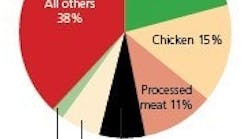Cutting to the meat of the matter, the $44.5 billion red meat industry posted an 18 percent increase in sales between 2002 and 2004, and a 39 percent increase since 1999, according to Mintel International. Such robust sales are partially attributed to the popularity of the Atkins diet, but consumption rates are not expected to change dramatically over the next few years.Americans love their beef. The December 2003 discovery of a cow infected with bovine spongiform encephalopathy (mad cow disease) caused only a tiny dip in domestic sales, although exports are still suffering.Nine of 10 Americans eat beef, many of them twice a week or more. Hispanics are more likely than the overall population to eat beef (85 percent on average compared to 75 percent), and since the Hispanic population is increasing so rapidly, their influence and preference for cooking meals at home is being felt in supermarkets.Top Choices for Dinner
Annual per capita consumption of beef was 64.9 lbs. in 2003, the more recent year for figures, according to the American Meat Institute (www.meatami.com), Washington. According to Cattlemen's Beef Promotion and Research Board (www.beefboard.org), Centennial, Colo., ground beef leads fresh meat sales with 59 percent, followed by steak (22 percent), ribs, kabobs, stew meat, etc., (10 percent) and roasts (9 percent). Steak eaten "as is" is the single most popular beef dish, eaten more than once a month by the average person, according to NPD Group's National Eating Trends research. We love to toss it on the barby.Surprisingly, according to the U.S. Dept. of Agriculture, low-income consumers eat steak nearly as often as the wealthiest, reports meatingplace.com. Low-income Americans, defined as households earning 130 percent or less of the federal poverty guidelines ($15,961 for a family of four), eat 72 lbs. of beef per capita per year. Low-income households are also No. 1 consumers of processed beef, "other cuts," and "beef dishes," but are marginally less likely than other groups to eat stew beef.When developing prepared food products containing beef, the modus operandi is the use of intense spices and flavors. According to the American Spice Trade Assn., onion and garlic rank as the top two flavors consumers pair with beef, but other popular flavors can add an unexpected boost to the palate and bottom line sales. Consumers from the Northeast and West prefer the widest range of flavor enhancers. Hispanics and Asians seem to have the most sophisticated palates, though they lean toward flavors from their native countries.A study on beef's popularity, conducted by Shugoll Research, found consumers consider it versatile and easy to prepare. Consumers say beef also provides unparalleled eating pleasure, and its flavor, aroma and appearance trigger a sense of well-being like no other meat.Calorie-for-calorie, beef is one of the most nutrient-rich foods. A 3-oz. serving of lean beef contributes less than 10 percent of calories to a 2,000-calorie diet and supplies more than 10 percent of the daily values of protein, zinc, vitamin B12, selenium, phosphorus, niacin, iron and riboflavin.Consumers have no beef with that.


